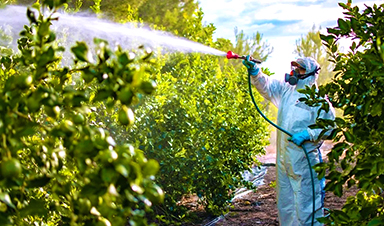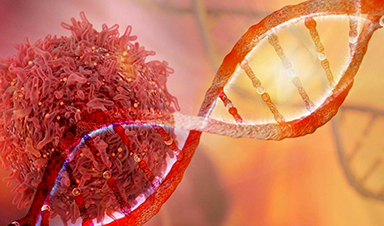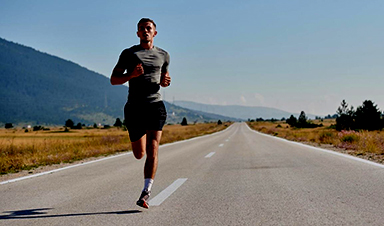Nanotechnology research offers a realistic and efficient method for reducing pesticide waste and enhancing pesticide consumption. A new publication in the journal ACS Agricultural Science & Technology discusses the development of chlorpyrifos-loaded silica nanomaterials enhanced with polydopamine (Cpf-MSNs@PDA) for intelligent pest management.
The release of chlorpyrifos from the hybrid composite was alkali- and heat-dependent, ensuring the effective constituent’s continuous and consistent efficacy over an extended period. The creation of an intelligent nanoparticle for the management of a specific plant diseases generates new ideas for organic farming.
Importance of Pesticides
Pesticides are critical for reducing and managing plant diseases, bugs, and weeds, which are necessary for agricultural production, repairing around 30% of worldwide crop damage. However, more than 90% of conventional pesticides infiltrate the ecosystem during the deposition process, resulting in environmental damage.
Presently, it is believed that developing a controlled-release pesticide technology would efficiently decrease pesticide wastage and increase pesticide consumption. With the advancement of nanomaterials and their widespread use in crop production, several novel pesticide compositions have been created, including nano caplets, nanoliposomes, and nanogels.
Various nanoparticles, including graphene oxide, charcoal, elastomer, and kaolin minerals, have been employed as pesticide carriers so far.
Mesoporous Silica Nanoparticles (MSNs) as Pesticide Carriers
Additionally, the conveniently synthesized surface morphology of MSNs enables the incorporation of adaptable substances or polymeric materials, enabling the development of a nanopesticide delivery mechanism that is responsive to external stimuli (such as pH, illumination, and heat) and thus enables the controlled release of pesticide elements.
Polydopamine (PDA): pH-Responsive Gatekeeper Molecule
To achieve the precise reaction of a nanopesticide to environmental stimuli, the nanocomposite’s surface layer is often altered with reactive gatekeeper molecules. Due to its excellent biological properties, high adhesion, and high photocatalytic effectiveness, polydopamine (PDA), a substance derived from mussels, has garnered significant interest. PDA’s superior film-forming capacity enables it to be uniformly deposited on the exterior of a wide variety of materials for general applications. Additionally, several studies have shown that PDA can be employed as a pH-responsive gatekeeper molecule to regulate drug delivery systems.
Development of an Intelligent Nanopesticide Composite
In this study, the researchers developed a smart nanopesticides compound based on a PDA-modified mesoporous silica nanocomposite (MSN) structure that helps pesticide particles to be released in response to an alkaline stimulus.
Chlorpyrifos (Cpf), a wide-spectrum organophosphate pesticide with dermal contact and gastro toxicity, was chosen as the prototype pesticide due to its widespread usage in farming to control pests. The release rate of Cpf was thoroughly investigated in the presence of pH and other biogenic triggers. Cpf-foliar MSNs@PDA’s adherence, rainfall-runoff tolerance, and pesticide effectiveness were also investigated to determine its durability.
Research Conclusion and Prospect
In conclusion, Cpf-MSNs@PDA, an alkali-triggered nanoscale pesticide combination, was developed in this work. The microporous morphology on the interface of the MSNs was restricted due to the containment of PDA, which limits the extraction efficiency of Cpf into the external environment.
To produce the alkaline-triggered discharge of Cpf-MSNs@PDA, PDA works as a pH-responsive barrier molecule. This novel composite was discovered to have outstanding foliar adherence and great rainfall erosion resistance in simulated testing, indicating that it can significantly prevent pesticide losses due to leaf slippage and rainfall runoff. The presence and degradability of pesticides in the midgut were established by inspection of the gastrointestinal tissue of M. separata, and the probable mechanism of Cpf-MSNs@PDA was established.
This research suggests a viable method for reducing pesticide wastage and contamination in the ecosystem. However, simulated results may not provide accurate physical results. Therefore, field studies should be conducted to improve the efficacy of nanopesticide compounds in the future.
News
Concerning New Research Reveals Colon Cancer Is Skyrocketing in Adults Under 50
Colorectal cancer is striking younger adults at alarming rates, driven by lifestyle and genetic factors. Colorectal cancer (CRC) develops when abnormal cells grow uncontrollably in the colon or rectum, forming tumors that can eventually [...]
Scientists Discover a Natural, Non-Addictive Way To Block Pain That Could Replace Opioids
Scientists have discovered that the body can naturally dull pain through its own localized “benzodiazepine-like” peptides. A groundbreaking study led by a University of Leeds scientist has unveiled new insights into how the body manages pain, [...]
GLP-1 Drugs Like Ozempic Work, but New Research Reveals a Major Catch
Three new Cochrane reviews find evidence that GLP-1 drugs lead to clinically meaningful weight loss, though industry-funded studies raise concerns. Three new reviews from Cochrane have found that GLP-1 medications can lead to significant [...]
How a Palm-Sized Laser Could Change Medicine and Manufacturing
Researchers have developed an innovative and versatile system designed for a new generation of short-pulse lasers. Lasers that produce extremely short bursts of light are known for their remarkable precision, making them indispensable tools [...]
New nanoparticles stimulate the immune system to attack ovarian tumors
Cancer immunotherapy, which uses drugs that stimulate the body’s immune cells to attack tumors, is a promising approach to treating many types of cancer. However, it doesn’t work well for some tumors, including ovarian [...]
New Drug Kills Cancer 20,000x More Effectively With No Detectable Side Effects
By restructuring a common chemotherapy drug, scientists increased its potency by 20,000 times. In a significant step forward for cancer therapy, researchers at Northwestern University have redesigned the molecular structure of a well-known chemotherapy drug, greatly [...]
Lipid nanoparticles discovered that can deliver mRNA directly into heart muscle cells
Cardiovascular disease continues to be the leading cause of death worldwide. But advances in heart-failure therapeutics have stalled, largely due to the difficulty of delivering treatments at the cellular level. Now, a UC Berkeley-led [...]
The basic mechanisms of visual attention emerged over 500 million years ago, study suggests
The brain does not need its sophisticated cortex to interpret the visual world. A new study published in PLOS Biology demonstrates that a much older structure, the superior colliculus, contains the necessary circuitry to perform the [...]
AI Is Overheating. This New Technology Could Be the Fix
Engineers have developed a passive evaporative cooling membrane that dramatically improves heat removal for electronics and data centers Engineers at the University of California San Diego have created an innovative cooling system designed to greatly enhance [...]
New nanomedicine wipes out leukemia in animal study
In a promising advance for cancer treatment, Northwestern University scientists have re-engineered the molecular structure of a common chemotherapy drug, making it dramatically more soluble and effective and less toxic. In the new study, [...]
Mystery Solved: Scientists Find Cause for Unexplained, Deadly Diseases
A study reveals that a protein called RPA is essential for maintaining chromosome stability by stimulating telomerase. New findings from the University of Wisconsin-Madison suggest that problems with a key protein that helps preserve chromosome stability [...]
Nanotech Blocks Infection and Speed Up Chronic Wound Recovery
A new nanotech-based formulation using quercetin and omega-3 fatty acids shows promise in halting bacterial biofilms and boosting skin cell repair. Scientists have developed a nanotechnology-based treatment to fight bacterial biofilms in wound infections. The [...]
Researchers propose five key questions for effective adoption of AI in clinical practice
While Artificial Intelligence (AI) can be a powerful tool that physicians can use to help diagnose their patients and has great potential to improve accuracy, efficiency and patient safety, it has its drawbacks. It [...]
Advancements and clinical translation of intelligent nanodrugs for breast cancer treatment
A comprehensive review in "Biofunct. Mater." meticulously details the most recent advancements and clinical translation of intelligent nanodrugs for breast cancer treatment. This paper presents an exhaustive overview of subtype-specific nanostrategies, the clinical benefits [...]
It’s Not “All in Your Head”: Scientists Develop Revolutionary Blood Test for Chronic Fatigue Syndrome
A 96% accurate blood test for ME/CFS could transform diagnosis and pave the way for future long COVID detection. Researchers from the University of East Anglia and Oxford Biodynamics have created a highly accurate [...]
How Far Can the Body Go? Scientists Find the Ultimate Limit of Human Endurance
Even the most elite endurance athletes can’t outrun biology. A new study finds that humans hit a metabolic ceiling at about 2.5 times their resting energy burn. When ultra-runners take on races that last [...]





















